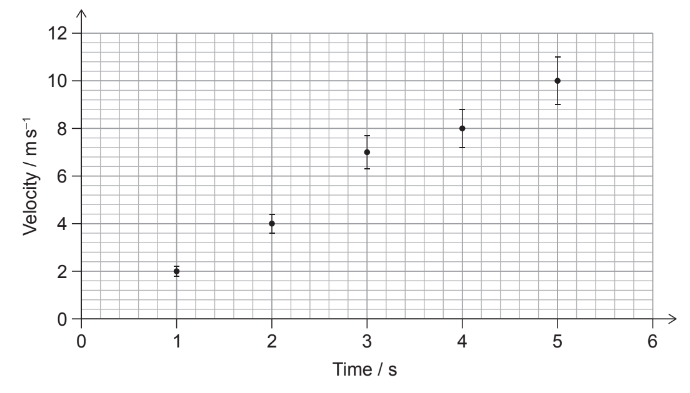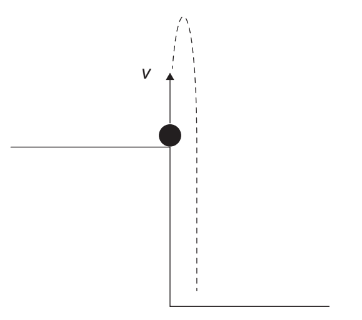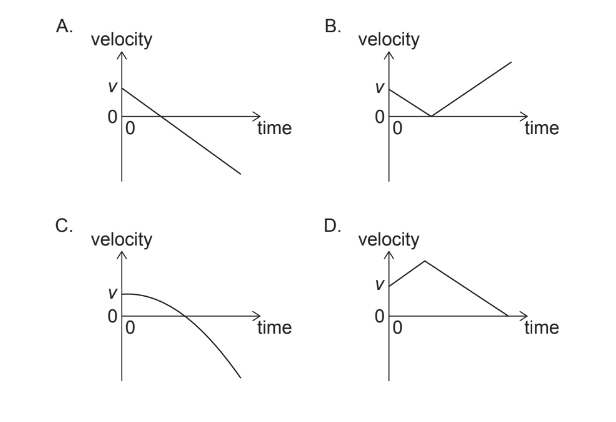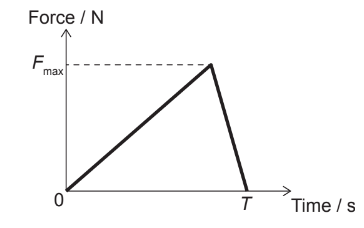2023-May-Physics_paper_1__TZ2_SL – All Questions with detailed solution
2023-May-Physics_paper_1__TZ2_SL
Topic: Uncertainties and errors
Given: The graph shows the variation with time of the velocity of an object. Error bars for velocity are included.

Calculate:Percentage uncertainty for the velocity at time \(t=4 \mathrm{~s}\) ?
A. \(\pm 20 \%\)
B. \(\pm 10 \%\)
C. \(\pm 8 \%\)
D. \(\pm 5 \%\)
▶️Answer/Explanation
Ans:B
One block will equal to $0.4 m/s$ and at t=4 velocity is 8 m/s
\(\begin{aligned} & v=8~ m /s \\ & \because \frac{\Delta v}{v} \times 100 =\frac{0.8}{8} \times 100 \\ & \frac{80}{8}=10 \% \\ & \end{aligned}\)
2023-May-Physics_paper_1__TZ2_SL
Topic: Motion
Given: A toy car of mass \(2 \mathrm{~kg}\) is at rest on a horizontal surface. A force of \(30 \mathrm{~N}\) is applied to the toy car at time \(t=0\). Frictional forces of \(10 \mathrm{~N}\) act on the toy car throughout its motion.

Calculate:speed of the toy car at \(t=2 \mathrm{~s}\) ?
A. \(10 \mathrm{~ms}^{-1}\)
B. \(20 \mathrm{~ms}^{-1}\)
C. \(30 \mathrm{~ms}^{-1}\)
D. \(40 \mathrm{~ms}^{-1}\)
▶️Answer/Explanation
Ans:B
To find the speed of the toy car at \(t=2 \, \text{s}\), we can use Newton’s second law of motion, which relates force, mass, and acceleration:
\[F = m \cdot a\]
\[F_{\text{net}} = 30 \, \text{N} – 10 \, \text{N} = 20 \, \text{N}\]
Now, we can calculate the acceleration of the toy car:
\[a = \frac{F_{\text{net}}}{m} = \frac{20 \, \text{N}}{2 \, \text{kg}} = 10 \, \text{m/s}^2\]
Next, we can use the following kinematic equation to find the speed (\(v\)) of the toy car at \(t=2 \, \text{s}\):
\[v = u + at\]
\[v = 0 + (10 \, \text{m/s}^2) \cdot (2 \, \text{s}) = 20 \, \text{m/s}\]
So, the speed of the toy car at \(t=2 \, \text{s}\) is \(20 \, \text{m/s}\).
2023-May-Physics_paper_1__TZ2_SL
Topic: Motion Under Gravity
Given:A stone is thrown vertically up from the top of a cliff with a velocity v at time t = 0. Air resistance is negligible.

Discuss:variation with time of the velocity of the stone until it hits the ground?

▶️Answer/Explanation
Ans:A
Initially (t = 0): The stone has an initial velocity of
v in the upward direction. The velocity is positive because it is moving upward.
As the stone ascends: The stone will experience the effect of gravity, causing its velocity to decrease. It will continue to move upward until it reaches its highest point, where its velocity becomes zero.
At the highest point: The stone briefly comes to a stop, and its velocity is zero. This is the point of maximum height.
On the way down: After reaching its highest point, the stone begins to fall under the influence of gravity. Its velocity is now negative (downward), and it increases in magnitude as it falls.
2023-May-Physics_paper_1__TZ2_SL
Topic: Motion
Given: Ball 1 is released at rest from the top of a building. At the same instant in time, Ball 2 is projected horizontally from the same height. The effect of air resistance is negligible.

Discuss:The true statement.
A. The velocity on impact with the ground is the same for both balls.
B. The time taken to hit the ground is greater for Ball 2 .
C. The speed on impact with the ground is the same for both balls.
D. The velocity on impact with the ground is greater for Ball 2 .
▶️Answer/Explanation
Ans:D
The correct statement is The velocity on impact with the ground is greater for Ball 2.
Here’s the explanation:
1. Ball 1 is released at rest from the top of the building. This means it starts with an initial vertical velocity of 0. It falls freely under the influence of gravity, so its final velocity upon impact with the ground is determined solely by the time it takes to fall and the acceleration due to gravity.
2. Ball 2 is projected horizontally from the same height. Since there is no initial vertical velocity, it will also fall under gravity and take the same amount of time to reach the ground as Ball 1. However, it also has an initial horizontal velocity, and this horizontal velocity is maintained throughout its motion. As a result, when it reaches the ground, its horizontal velocity is nonzero.
2023-May-Physics_paper_1__TZ2_SL
Topic: Forces
Given: A variable force with a maximum \(F_{\max }\) is applied to an object over a time interval \(T\). The object has a mass \(m\) and is initially at rest.

Calculate:speed of the object at time \(T\) ?
A. \(\frac{F_{\max } T}{2 m}\)
B. \(\frac{F_{\max } T}{m}\)
C. \(F_{\max } T m\)
D. \(2 F_{\max } T m\)
▶️Answer/Explanation
Ans:A
\[
\text { Area }=\Delta m v=\frac{\text { Fmax }\cdot T}{2}
\]
\(mv-m \times 0=\frac{\text { Fmax }\cdot T}{2}\)
\(v= \frac{\text { Fmax }\cdot T}{2m}\)
